News Item
now browsing by category
Tribe Adopts “Tribal Seal Protection Ordinance”
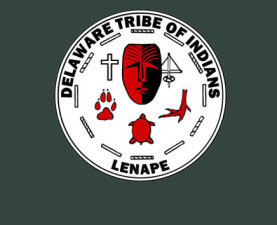
Adopted at March 17, 2015 Tribal Council meeting. Text of ordinance is below:
» Tribal Seal Protection Ordinance
Repatriations and Culture Camp Planned for 2015

By Brice Obermeyer, Delaware Tribe Historic Preservation Office
As 2014 draws to a close our office is pleased to share with you our progress on several important projects and upcoming events for the new year. Although the year has seen many significant achievements and day-to-day consultation, we are particularly pleased to announce the completion of our cultural affiliation studies which will pave the way for our upcoming repatriation and reburials for two very large cemeteries in Pennsylvania and New Jersey.
Over the past several years we have focused our efforts on the larger collections that are housed in the State Museum of New Jersey and Pennsylvania. The single largest collection of Delaware human remains were excavated from a large Delaware occupation site known as the Abbott Farm National Historic Landmark. It is located in the lower Delaware Valley near where Trenton, NJ is today. Over 100 individuals have been excavated and removed from the site over the past 100 years. The second very large collection comes from a historic Delaware cemetery associated with the historic Delaware village of Kuskuskies in western Pennsylvania. The cemetery is known archaeologically as the Chambers Site and at least 80 individual graves were identified during the excavation of this site in the 1960s.
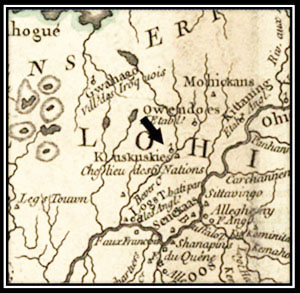
18th-century map showing the Kuskuskies village.
Our first step was to identify all of the museums that hold a portion of these collections and those are listed in the paragraph above. The second is to document that these individuals were Delaware. Documenting the so-called cultural affiliation of the collection is a necessary step before the tribe can repatriate the collection under NAGPRA. We are pleased to announce that we completed the cultural affiliation of the Chambers site in January and we completed the Abbott Farm cultural affiliation report in November. Our next step is to submit these reports to the museums and potentially affiliated tribes so we can move on to the next step of repatriating these very large and significant collections.
Our next step in the coming year then is to move forward with the repatriation of the Chambers and Abbott Farm collections. We have identified the sites at which these collections will be reburied as both are very near the places where the graves were originally located and offer secure locations for the reburied remains to be placed. We have identified the Schoenbrunn Historic Village in Ohio as the place where we will rebury the Chambers collection and Pennsbury Manor near Philadelphia, PA will be the place for the reburial of the Abbott Farm burials.
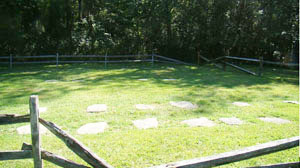
Schoenbrunn.
Schoenbrunn is a reconstruction of the Moravian Mission village that was originally established for the Delaware while they lived in the Ohio country. There is a cemetery there on the site that houses Delaware graves that would have been contemporary with the Chambers site graves. We plan to expand this cemetery to include the graves of the Chambers collection. We anticipate this reburial to take place in the summer of 2015 and we are currently applying for funding to assist with the repatriation.
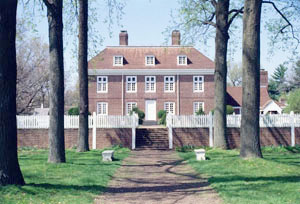
Pennsbury Manor.
Pennsbury Manor is the reconstructed home of William Penn, the Quaker founder of the Pennsylvania colony and original negotiator for Delaware lands in the lower Delaware valley. This property also holds a small cemetery that is reported to have a Delaware buried there as well. Similar to the Schoenbrunn plan, we anticipate expanding this cemetery to include the individuals from Abbott Farm as well. With the Chamber repatriation in 2015, we anticipate the Abbott Farm repatriation to take place the following year.
Along with the planned repatriations, we are equally excited to announce that plans are in place to establish a cultural preservation camp that will be held next summer at the Delaware Water Gap National Recreation Area in northeastern Pennsylvania. This camp will be open to a limited number of high school aged members of the Delaware Tribe, Delaware Nation, and Stockbridge-Munsee, and will provide an educational experience in which students will learn more about Delaware culture and history while living in the Delaware homeland. The camp will be jointly run and led by representatives from the three Delaware tribes, Park staff and local professionals. The camp will be supported by NPS funds that are available for such activities but space will be limited based on how much funding is made available. Please contact Brice Obermeyer at bobermeyer@delawaretribe.org if you are interested in having your high school-aged child participate in the upcoming culture camp.
New Article in Culture and Language Section

Want to know more about Lenape culture?
Jim Rementer has added an article entitled “Lenape Feather Mantles or Capes” to the Culture and Language section of the web site.
To open the article directly, click here.
To learn more about Lenape clothing, go to Culture and Language and choose the Lenape Clothing tab or click here. To learn about other aspects of Lenape life, click on one of the other tabs.
UPDATE, November 5: Another article has been added, this one in Delaware ethnobotany. To open the article directly, click here, or go to Culture and Language and choose the Lenape Life tab.
Justice Sonia Sotomayor Meets with Tribal Leaders

 |
 |
On September 11 Chief Pechonick attended a meeting and luncheon at the Oklahoma Judicial Center in Oklahoma City to meet with Justice Sonia Sotomayor, Associate Justice of the United States Supreme Court. Sotomayer had requested this special meeting with the Oklahoma tribal leaders to hear their concerns.
Delaware Water Drum


On July 8, at 6 p.m., a group of Delaware men met, as they often do on Tuesday nights, at the Delaware Community Center to drum and sing. This particular evening was special because elder, Dee Ketchum, was teaching Bear Tompkins, who is 25, how to tie the water drum for the first time.
First, a piece of buckskin is wet and stretched over a small brass kettle. The brass kettle is then filled about one-quarter full with water.
“One of the Jackson boys gave me these stones. We tie [the drum] off with the seven,” Dee Ketchum said.
According to Ketchum, the perfect number of the ancestors was seven. When the drum is finished, there should be a seven-point star on the bottom of the kettle made from the rope crossing back and forth.
“This is special rope… I had to go to Hominy to get it. You have to have a rope that won’t stretch,” Ketchum said.
The end of a deer antler is used to measure the distance between each stone. There is a mark notched into the antler for this purpose. Under the leather, stretched over the drum, each stone is placed one-by-one, and the rope is wrapped around them.

Once the rope is secured around the stone under the leather, Ketchum instructed Tompkins about what to do next.
“I just hold onto the drum and hold the rope down,” he said.
“You have it. Get it really good and tight or it will pull out,” Ketchum said as Tompkins finished securing the first stone.
Ketchum continued with his instructions as Tompkins tied the drum: “I start with the first stone over that first leg. You put the next stone in after measuring it right up on the lip.
“For each stone, you do the same thing. Measure it off, put it up underneath there, take the stone and tie it off.”
“Tie off all the stones first, then [with the rope] you start going under [the kettle]. There really aren’t many people who know how to tie the water drum.”
“When you pull them, you’ll see how important it is to have them tight. The frustrating thing is you get half way around and a stone starts to come out,” he explained.
“It just takes practice.”
“You haven’t gotten to the hard part yet.
“Bring the rope under the brass kettle to the other side by going over the top and then holding the drum and stepping on the secured rope; secure it on the other side,” Ketchum said.
As Tompkins patiently stood on the rope to tighten it, Ketchum said: “[s]ome guys just jump on it.”
After a few minutes, Ketchum instructed Tompkins: “take your foot off. It’s twisted and then you secure it on the other side.”
“Okay, you’re doing good.”
“Then you stick the remaining rope in there or you go around it,” Ketchum said.
After about 45 minutes, the drum was finished and the group began singing. They started with a song, which began, “Hey Johnny Boy” and continued in the Lenape language. “Ho ha way ho ya na…”
Ketchum told the group that the leather had been secured well and that the drum would become tighter as it dried.
“He did pretty good for his first time,” Ketchum said.
“Do you think you can remember that?” he asked.
“I hope,” Tompkins replied.
“In the old days they’d use a hollowed out log. Leave the bottom in it,” said Todd Thaxton, who was among the men sitting in the circle.
“They would burn them out to hollow them out like they did the canoes. They’d get rawhides to put over — the tighter, the better. If too tight, it’s hard to tie down,” Thaxton added.
Ketchum handed Tompkins the drum and he tried it out.
Then Tompkins called his mom on the cell phone and said, “Mom, listen to this. It’s the drum I just tied!”
The group sang several songs using the water drum.
Regarding the songs, Ketchum said, “I know about 20 – 25 of these. Go Get ‘Em and the Duck Dance are easiest to learn. The Keetoowah is the hardest to learn; it’s kind of a love song. Only the women start that dance. You’re kind of calling in the women.”
“Fred Falleaf found some tapes of Bill Shawnee but he died before he could give them to me. We’ve lost so many songs. These songs had words and meanings to them. We use these in our social dances; they’re not Pow Wow or war songs for us. Once a year they came together and sang these songs. In particular, the cultural dances were held at harvest time to show their appreciation for the growth of the vine that fed all the people. We sang the songs for that reason. The songs were to socialize. They’re not ceremonial songs.”
With regard to the stomp dances, Ketchum explained: “These songs are done out around a fire after the sun’s gone down. Delaware go counter-clockwise around the fire. When Bear [Tompkins] was headman dancer, he went counter-clockwise. He did it the right way.”
The reason for dancing counter-clockwise is that on the left is where one’s heart is, he explained.
“All the good feelings come from the heart side. That’s why we shake hands left-handed because that’s on the heart side and then all the good feelings go to the drum and go up to our Creator.
“I say, ‘don’t even come out to dance unless you have good feelings.'”
Chief Paula Pechonick, recalled a time when a group had gone to Saint Angelo and Ketchum was tying the drum that day.
Chief Pechonick said, “it was a very hot day and Dee had a hard time, but he got it tied before it was time to drum!”
Ketchum added, “Our ancestors used this smaller drum. They used the kettle a lot when they became available. They brought the crock or pot. That goes way back.”
Other tribes also use the water drum, Ketchum said.
“We’re not a peyote people, but other tribes use [the water drum] in those ceremonies too — Osage, for example.”
After the evening of singing was over, the drum was disassembled, and the water emptied from the kettle.
As the evening concluded, Ketchum said, “the culture is the most important thing — more important than individual recognition. At some point, we’ll all be gone, but hopefully, they’ll keep our culture alive.
“The culture identifies the tribe and that’s why we’re trying to keep it alive. Without it, we might as well be a club.”
The water drum is on display at the Bartlesville Area History Museum’s Delaware Tribe exhibit with a life-sized replica of Ketchum playing the drum.
“Lenape on the Wapahani” Wins Film Award
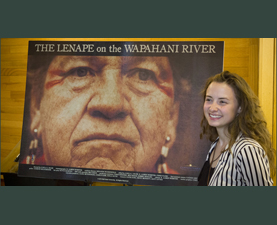
Our friend Chris Flook from the Ball State University Telecommunications Department reports that the “Lenape on the Wapahani River” documentary recently won a Platinum – Best of Show for Historical Documentaries at the Aurora Awards. Auroras are awards given to video and film productions that don’t usually have traditional theatrical releases.
The documentary has now one four international awards:
- An Accolade Award of Merit for Titles and Graphics
- An Accolade Award of Merit for Cinematography
- An Accolade Award of Excellence – Best Documentary
- An Aurora Platinum Best of Show – Historical Documentary
The documentary, prepared by Communications Department students, through filmed re-enactments and interviews, chronicles the forced migration of the Delaware Tribe from their original home in the region now known as southern New York, New Jersey and Delaware through: Pennsylvania, Ohio, Indiana, Missouri, Kansas and present-day Oklahoma.
The documentary may be viewed at www.lenapeonthewapahani.org.
Ethnobotanist Visits Tribal Headquarters

George Hill, who in 1972 wrote a paper Delaware Indian use of plants, published in Oklahoma Anthropological Newsletter (March 1972), visits with Chief Paula Pechonick.
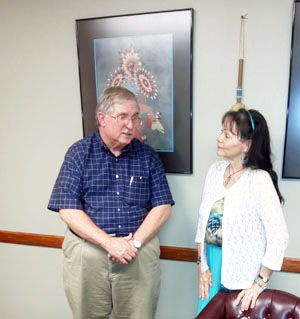
The 50th Annual Delaware Pow Wow, by Mary Watters

War Mothers Entry – When they came in, I was particularly proud of our Granddaughter, Jennifer Revard. She came in and I’m sure you noticed her headdress. Her Aunt made this for her because she doesn’t have any hair yet. She’s been through a very bad year of breast cancer and so her hair hasn’t completely started to grow back in yet. She wanted to dance and she wanted to wear her traditional dress, “so you know I can’t dance without something on my head” and our ansipelaona doesn’t cover all your hair, just the back. So anyway Laura did some research and she found a picture of Susan Elkhair in some of the papers of the history of the Delaware. Laura ordered a hat, a top hat, and bought a little sheet of metal. She got some creepers to cut the metal. She fixed a band around this hat. She got feathers to go around the band. A friend helped with the feathers that decorated this hat. And this hat is what Jennifer wore. It created a stir because this had not been seen in years and years. She was very proud to wear it and represent the Elder Delaware. That night afterwards, Mike Pace, whose mother was from the Elkhair family, presented Jennifer with a broach that had belonged to Susan Elkhair and had been passed down through generations to him. He ended up with it and he gave it to Jennifer. So it was really an emotional and happy time because she told us all “Thank You” for this past year what she’s been through and what her friends and family and relatives have helped her and she said “it’s over and I won”! And this was really a special moment for me and this moment that we had our honor dance as Gilbert and I were picked as “Honor Elders” and we were led in by our grandsons, great grandsons and grandsons- in- law. They reached across the arena in front of us as we came in and then we had about, I can’t remember how many came and shook hands with us and how they made us feel completely honored. It was one of the most special moments in our lives and we appreciate everybody that was there and everybody that came and shook hands with us. It was a wonderful, wonderful Pow Wow to me.
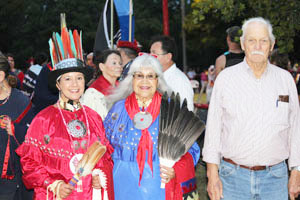 Jennifer Revard with her headdress, flanked by Mary and Gilbert Watters. |
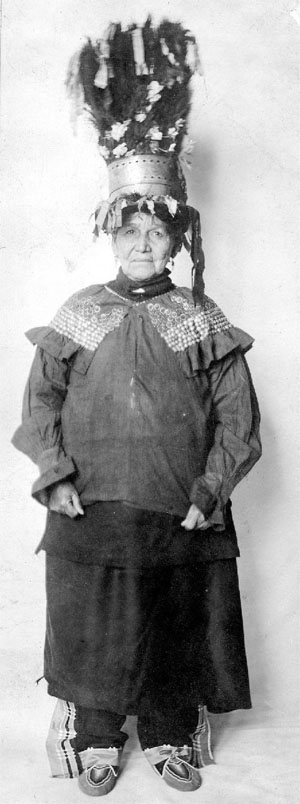 Susan Elkhair wearing the original headdress. |
Thoughts on the 50th Annual Delaware Powwow

By Bear Tompkins, Head-Man Dancer
 My name is Bear Tompkins, I am a member of the Delaware tribe, and I was the head-man dancer at the Delaware powwow. This year was the 50th annual Delaware powwow. It was a very memorable powwow and a very big honor for my family and me. We were honored when the powwow committee asked me to be this year’s head-man dancer. My parents Ray and Sandy Tompkins pre- pared for an entire year, getting everything ready for my special, and my mom spent a considerable amount of time on my regalia (outfit). I am very thankful for them and all the support they gave me through this. My grandparents Walt and Pat Donnell have always worked hard every year to prepare our camp for the upcoming year. My grandmother has always helped with my regalia and she made me a brand new shirt and vest for this year’s powwow. My uncle Doug sang his song for my special. I remember last year when I was asked to be head-man, I went to my uncle right away and asked him to sing a song for me. He said he would and he did not disappoint. The song he sang was composed for him and it was such an honor for him to sing it for my special. My great uncle Dee Ketchum spoke for me at my special. All of my family was there this year to support me, of course, they are there every year. But they showed me how much they care and how much they love me by all pitching in and helping out with the process. I could not have done anything without them. I am truly blessed to have such a wonderful family.
My name is Bear Tompkins, I am a member of the Delaware tribe, and I was the head-man dancer at the Delaware powwow. This year was the 50th annual Delaware powwow. It was a very memorable powwow and a very big honor for my family and me. We were honored when the powwow committee asked me to be this year’s head-man dancer. My parents Ray and Sandy Tompkins pre- pared for an entire year, getting everything ready for my special, and my mom spent a considerable amount of time on my regalia (outfit). I am very thankful for them and all the support they gave me through this. My grandparents Walt and Pat Donnell have always worked hard every year to prepare our camp for the upcoming year. My grandmother has always helped with my regalia and she made me a brand new shirt and vest for this year’s powwow. My uncle Doug sang his song for my special. I remember last year when I was asked to be head-man, I went to my uncle right away and asked him to sing a song for me. He said he would and he did not disappoint. The song he sang was composed for him and it was such an honor for him to sing it for my special. My great uncle Dee Ketchum spoke for me at my special. All of my family was there this year to support me, of course, they are there every year. But they showed me how much they care and how much they love me by all pitching in and helping out with the process. I could not have done anything without them. I am truly blessed to have such a wonderful family.
The powwow this year was great! Thursday night, the Culture Preservation, had their night out at the powwow grounds. The turnout was really big and a lot of young kids and children were stomp dancing around the fire and dancing to our Lenape social dance songs. Friday and Saturday night the powwow was in full effect. The dancers were looking keen in their regalia and the drum sounded sweet! All of the Delaware families were camping out all weekend and the fires were kept burning all night. Some even got in a little trouble for being a little too rowdy! But that’s just kids being kids. Everyone seemed to enjoy themselves and that’s what it is all about. We all had a great time even if Sunday night was rained out. The 50th annual Delaware powwow was certainly one to be remembered. May God bless us all. Wanishi!
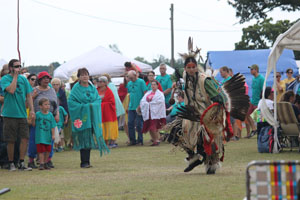 |
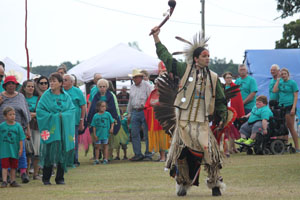 |

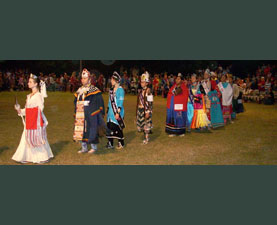

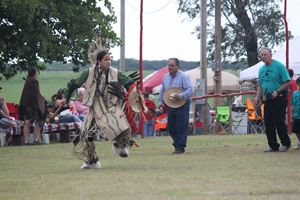
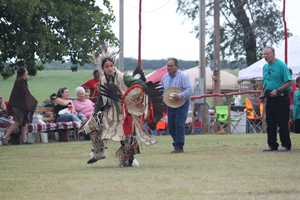

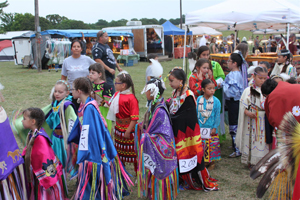


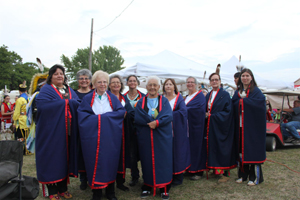
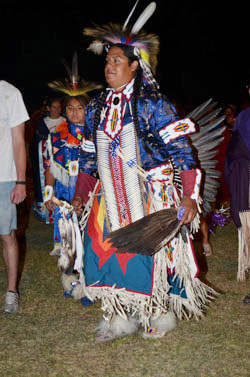
 D5 Creation
D5 Creation